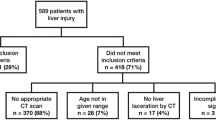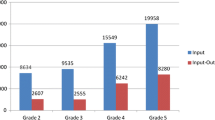Abstract
The purpose of this study was to determine the efficacy of CT to predict the development of bile leaks in hepatic trauma. This HIPAA-compliant retrospective study was IRB approved and consent was waived. All patients who sustained hepatic trauma between January 1, 2006, and January 31, 2012, and who underwent CT and hepatobiliary scans during the same hospital admission were included. One hundred and thirty-two patients met the inclusion criteria. Comparison between the presence of biliary injury relative to American Association for the Surgery of Trauma (AAST) hepatic injury grade and mean distance of the hepatic laceration to the inferior vena cava (IVC) was made. The ability of free fluid to predict bile injury was analyzed. Forty-one (31 %) of the 132 patients had positive hepatobiliary scans. Of these 41 patients, seven (17 %) sustained low-grade and 34 (83 %) sustained high-grade hepatic injury compared with the 37 (41 %) low-grade and 54 (59 %) high-grade hepatic injuries in the negative hepatobiliary scan group. The mean distance to the IVC was 2.4 cm (SD 2.9 cm) and 3.6 cm (SD 3.3 cm) in patients with and without bile leaks, respectively. A statistically significant difference in the proportion of high-grade injuries and the mean distance from the IVC between the two groups was identified. The presence of free fluid on CT is sensitive, but not specific, for detecting a bile leak. CT findings, including AAST liver injury grade and location of the liver laceration, are able to predict which patients are at risk for developing bile leaks as seen on hepatobiliary scintigraphy, whereas the presence of free fluid is not.






Similar content being viewed by others
References
Feliciano DV (2006) Biliary injuries as a result of blunt and penetrating trauma. Surg Clin N Am 74:897–907
Croce MA, Fabian TC, Menke PG et al (1995) Nonoperative management of blunt hepatic trauma is the treatment of choice for hemodynamically stable patients: results of a prospective trial. Ann Surg 221:744–755
Kozar RA, Moore FA, Cothren CC et al (2006) Risk factors for hepatic morbidity following nonoperative management. Arch Surg 141:451–459
Fleming KW, Lucey BC, Soto JA, Oates ME (2006) Posttraumatic bile leaks: role of diagnostic imaging and impact on patient outcome. Emerg Radiol 12:103–107
Wahl WL, Brandt MM, Hemmila MR, Arbabi S (2005) Diagnosis and management of bile leaks after blunt liver injury. Surgery 138:742–748
Bala M, Gazalla SA, Faroja M et al (2012) Complications of high grade liver injuries: management and outcome with focus on bile leaks. Scand J Trauma Resusc Emerg Med 20:20
Gerndt SJ, Seidel SP, Tahert PA, Rodriguez JL (1995) Biliary tract injury following blunt abdominal trauma: case reports. J Trauma 39:612–615
Chow S, Bosco JJ, Heiss FW, Shea JA, Qaseem T, Howell D (1997) Successful treatment of post-cholecystectomy bile leaks using nasobiliary tube drainage and sphincterotomy. Am J Gastroenterol 10:1839–1843
Bridges A, Wilcox CM, Varadarajulu S (2007) Endoscopic management of traumatic bile leaks. Gastrointest Endosc 65:1081–1085
Shanmuganathan K, Mirvis SE (1998) CT scan evaluation of blunt hepatic trauma. Radiol Clin North Am 2:399–411
Gupta A, Stuhlfaut JW, Fleming KW, Lucey BC, Soto JA (2004) Blunt trauma of the pancreas and biliary tract: a multimodality approach to diagnosis. RadioGraphics 24:1381–1395
Kapoor V, Baron RL, Peterson MS (2004) Bile leaks after surgery. Am J Roentgenol 182:451–458
Richardson JD, Franklin GA, Lukan JK et al (2000) Evolution in the management of hepatic trauma: a 25-year perspective. Ann Surg 232:324–330
Jiang H, Wang J (2012) Emergency strategies and trends in the management of liver trauma. Front Med 6:225–233
Mohr AM, Lavery RF, Barone A et al (2003) Angiographic embolization for liver injuries: low mortality, high morbidity. J Trauma 55:1077–1081
Becker CD, Gal I, Baer HU et al (1996) Blunt hepatic trauma in adults: correlation of CT injury grading with outcome. Radiology 201:215–220
Pachter HL, Hofstetter SR (1995) The current status of nonoperative management of adult blunt hepatic injuries. Am J Surg 169:442–454
Lubezky N, Konikoff FM, Rosin D et al (2006) Endoscopic sphincterotomy and temporary internal stenting for bile leaks following complex hepatic trauma. Br J Surg 93:73–81
Pioche M, Ponchon T (2013) Management of bile duct leaks. J Visceral Surg 150S:S33–S38
Melamud K, LeBedis CA, Anderson SW et al (2014) Biliary imaging: multimodality approach to imaging of biliary injuries and their complications. RadioGraphics 34:613–623
Conflict of interest
The authors declare that they have no conflict of interest.
Author information
Authors and Affiliations
Corresponding author
Additional information
This study was presented as a scientific poster in RSNA 2012.
Rights and permissions
About this article
Cite this article
LeBedis, C.A., Anderson, S.W., Mercier, G. et al. The utility of CT for predicting bile leaks in hepatic trauma. Emerg Radiol 22, 101–107 (2015). https://doi.org/10.1007/s10140-014-1262-9
Received:
Accepted:
Published:
Issue Date:
DOI: https://doi.org/10.1007/s10140-014-1262-9




